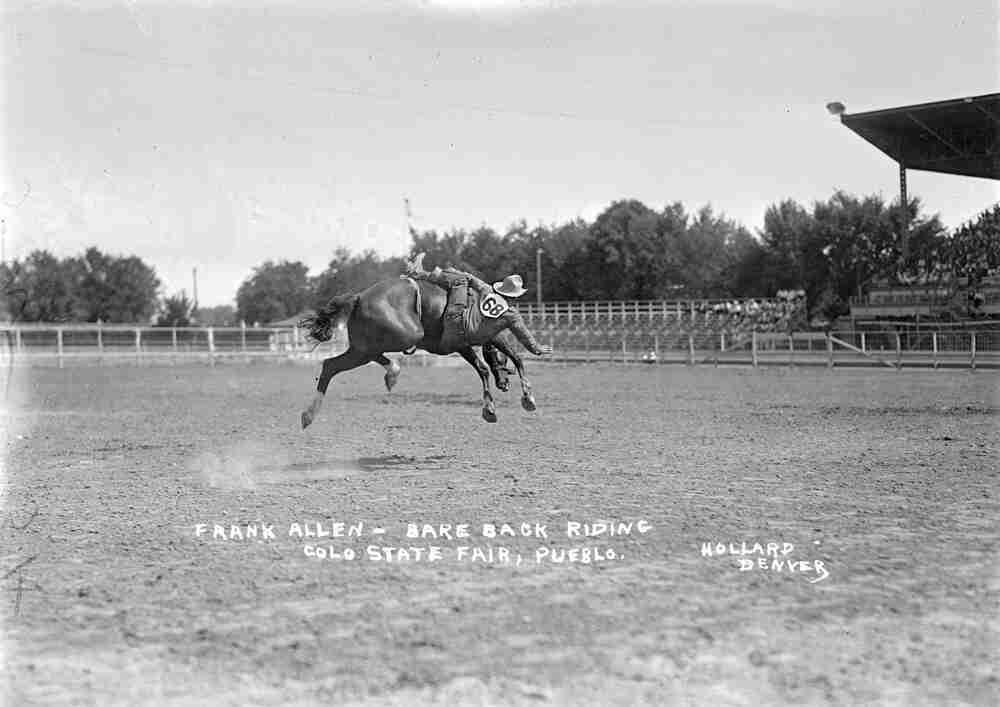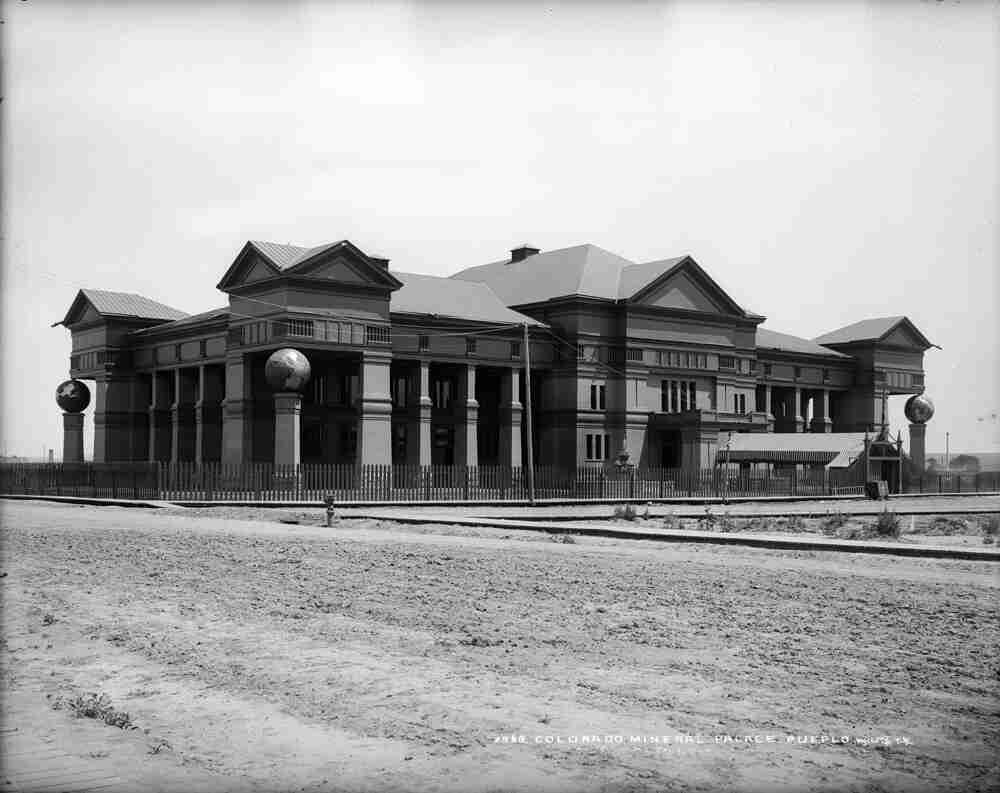Colorado State Fairgrounds
Full Article
Opened in 1901, the Colorado State Fairgrounds in Pueblo have long played an important role in the state’s agriculture, education, and entertainment. Farmers and ranchers attend the fair to display their products, see new technologies and techniques, and buy livestock, while others come to learn about agriculture or enjoy the rodeo. The Works Progress Administration (WPA) constructed many of Colorado’s fairgrounds facilities in the 1930s.
Origins of the Fair
Official state agricultural and industrial fairs started in the United States in the middle of the nineteenth century. The Colorado Agricultural Society held the territory’s first agricultural fair northwest of Denver in September 1866, featuring a half-mile racetrack as well as displays of large vegetables and prize livestock. Over the next two years, the fair expanded to include more agricultural exhibits as well as examples from the territory’s mining industry.
By the end of the 1860s, however, farmers in northern and southern Colorado were dissatisfied with the Denver fair. At the time, Colorado had about 1,700 farms and fewer than 100,000 acres under cultivation, most of them along the South Platte and Arkansas Rivers and their tributaries. Northern and southern Coloradans began to organize agricultural societies and fairs of their own, including the Southern Colorado Agricultural and Industrial Association, established in Pueblo in 1872. That October the association held a three-day fair on a 100-acre site north of Pueblo. The horse races were especially popular, with attendance on the final day reportedly reaching 1,400.
The Southern Colorado Agricultural and Industrial Association’s fairs continued for fifteen years at the same site north of Pueblo. After incorporating as the State Fair Association (SFA) in November 1886, the group spent $3,000 to secure a new site for the fair within Pueblo city limits at what is now Mineral Palace Park. The SFA spent an additional $5,000 on improvements to the site and held its first fair there the next summer. Already in 1890, however, the SFA sold the Mineral Park location for $48,000 and paid $30,000 for a new site west of Lake Minnequa, where it built a grandstand, exhibition hall, and racetrack. The Lake Minnequa site proved unpopular and soon suffered from low attendance because it was far from the train station and streetcar lines.
In 1900 the SFA increased its promotional efforts and purchased a new eighty-acre site that forms the core of the current fairgrounds. The new site was located along two streetcar lines, making it far more easily accessible than the Lake Minnequa site, and the SFA built a new half-mile racetrack, 300-foot-long grandstand, exhibition hall, and stables in time for the 1901 fair. With the new site, new buildings, and even a new date in September, attendance jumped to 16,000.
State Support and New Deal Expansion
The development of the Colorado State Fairgrounds followed a pattern common to many American state fairs. By the start of the twentieth century, fairs were adding more and larger buildings to accommodate spectacles such as horse racing, which was extremely popular at the time. Around 1900 fairs were also incorporating more amusements on the model of the Midway at the Chicago World’s Fair of 1893, which had been a huge success. After World War I, rodeos became an increasingly popular feature of fairs, especially in the West, and gradually displaced horse races as the fairs’ biggest draw.
Meanwhile, state governments began to invest in fairs in the 1910s and 1920s, providing the funding necessary to build more substantial fair facilities. In Colorado the legislature had become involved with the state fair for the first time in 1888, when it designated Pueblo the permanent location of the fair. In 1903 the fair received its first state appropriation to pay agricultural and horticultural premiums. In 1915 the legislature approved a $10,000 appropriation for the fair, but Governor George Carlson vetoed the measure. The problem of the fair’s exact relationship to the state was eventually solved in 1917, when the SFA deeded the fairgrounds to the state. The legislature created a State Fair Commission to run the fair and began to fund the fair’s operations.
Over the next two years the fairgrounds served as “Camp Carlson,” a base for Colorado militia troops training for World War I, resulting in limited fair operations in 1917 and 1918. The fair quickly rebounded in the 1920s with the addition of several new buildings thanks to state funding. During these years, the fair also began to add its first permanent 4-H buildings for youth agricultural education; the first 4-H camp was held at the fairgrounds in 1918 and quickly became an annual feature, hosting students every year thereafter except during World War II and the 1951 polio epidemic.
The fair experienced a golden age of growth and popularity from the 1930s to the 1950s, under the leadership of Ray Talbot and Frank Means. Talbot served as president of the State Fair Commission from 1931 to 1953, while Means managed the fair from 1936 to 1950. During that period, the fair’s attendance rose from 20,000 in the early 1930s to 200,000 in the early 1950s. The fair ended its deficits and began to generate a surplus.
Perhaps most important, Talbot brought New Deal projects to Pueblo and the fairgrounds during the Great Depression. The Federal Emergency Relief Administration and the WPA helped fund six new buildings at the fairgrounds as well as new walls, horse stables, and other infrastructure, while the Civilian Conservation Corps made a temporary camp at the fairgrounds. The final WPA building erected at the fairgrounds, the Palace of Agriculture, started construction in 1940 but was not finished until 1949, because of a lack of workers and material during World War II.
Brick, stone, or concrete and steel buildings replaced all the fair’s wooden structures during the first half of the twentieth century. None of the original 1901 fair buildings survive, with the last one being torn down in the early 1940s. Most of the New Deal–era buildings at the fairgrounds were made of local limestone. In 1944 all the existing brick buildings were coated in stucco and whitewashed to make them resemble the WPA’s limestone buildings and create a “White Way” effect—a term used to describe a brilliant, well-lit street, in reference to New York City’s Broadway. One of the more notable buildings added to the fairgrounds in the 1940s was the Rabbit Building (now the Natural Resources Building), which the fair billed at the time as the “Largest Rabbit Show Building in the World.”
Postwar Changes
Many of the changes that the Colorado State Fair experienced after World War II came in response to the urbanization and changing demographics of the Front Range. The fair emphasized entertainment to attract urban crowds who were less interested in agriculture, and added Fiesta Days to the schedule in 1967 to recognize the state’s Hispanic community. New construction added entertainment venues and concessions like the Coors Beer Garden (1953) and a band shell (1954). The last major agricultural building constructed at the fairgrounds was the livestock building, which was completed in 1964 at a cost of nearly $650,000.
The historic buildings at the fairgrounds (those constructed before 1965) share certain characteristics because of the seasonal nature and agricultural orientation of the fair. Designed for summer use, many of the buildings are not heated and have no glass in the windows. Exhibition buildings have oversized entrances to accommodate livestock and display booths. The biggest change to the fairgrounds site since 1965 was the removal of the original oval horseracing track in the 1980s and the addition of a new wall to divide the rodeo arena and grandstand from the rest of the fair’s horse buildings.
Recent History
After shrinking from seventeen days to eleven days in 2005, the Colorado State Fair has attracted roughly 500,000 visitors per year and provides an estimated $33 million for the state. Although the fair itself turns a profit, year-round staffing, maintenance, and operations at the eighty-acre fairgrounds cost millions of dollars. As a result, the fair posted a $928,000 operating loss in fiscal year 2014 and continues to evaluate opportunities for budget cuts.







